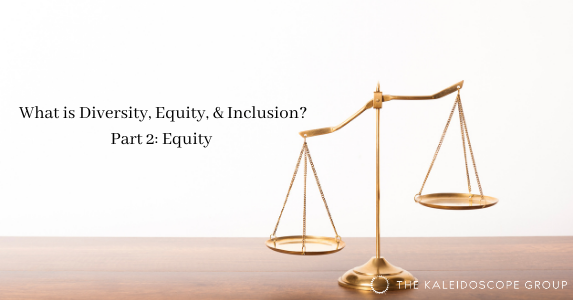What is Diversity, Equity, & Inclusion? Part 2: Equity
November 17, 2020

What is equity? This word has begun to be more and more a part of our discussions in the diversity space. Somehow, the word diversity wasn’t enough to define the landscape of sameness. To some, diversity simply demands that we need different voices, but it doesn’t speak to how we treat those with different voices. Part of the reason there is a lack of diversity is that people deliberately designed systems to discriminate against diverse groups of people. The word equity was included to point out that once you start to create diversity within your organization, you must ask some important questions: What are you going to do with that diversity? How are you going to cultivate it? And how do you want your people to feel, think, and act as a result of that diversity? Here are three components of equity you should keep in mind as you embark on a diversity and equity journey:
Equity is not Equality
In the dictionary, equity is defined as the quality of being fair and impartial. However, it is important to understand that equity is not equality. With equality, we treat everyone the same and give everyone access to the same opportunities. This sounds good if everyone was starting from the same vantage point. Take education for example, if everyone was given the same opportunity to attend an Ivy League school that would be a good thing right? The challenge in giving everyone the opportunity is found in the reality that everyone isn’t prepared for the challenge that school will present.
It is not enough to provide the opportunity without providing the preparedness. Equity says that these students who may require additional educational resources should get it in order to be more competitive. This additional assistance really bothers many people because they see it as being unfair to award extra assistance to some and not others. However, what is being ignored is that unfair educational opportunities are already at play. There is a group of people who are being advantaged educationally with where they live, what kind of schools they attend, and how much money they have. You cannot treat a historically discriminatory system and believe things will be fair by providing equality without equity.
The Interaction Institute for Social Change has a great example of equity in Illustrating Equality VS Equity which shows three young people attempting to watch a baseball game. With equality, each person is standing on a crate of equal height attempting to peer over a fence. One has a great view, one has an adequate view and one has no view at all. The individuals are of different heights so the same sized crate doesn’t take that fact into account. With Equity, each person has the same view of the game. In the illustration, one person can stand on his own feet without a crate to peer over the fence but the other two need crates of different sizes to be able to see the game. That is the definition of equity – providing each person what they need in order to be equal. While we all are created equal we are not all treated equally. Equity recognizes that we need to meet peoples’ needs and not simply increase opportunities.
Equity is Justice
Discriminatory practices against women in this country are well documented from what schools they could attend to what jobs they could hold and how far they can advance in a particular field. Take the issue of salaries for example equality is equal pay for equal work whereas equity is providing greater raises to women before in order to close the discrepancies in pay for the same work. The Center for American Progress reports that on average women make 82 cents for every dollar a man makes for the same job. In order for us to get to equality in pay, we are going to have to address equity. Women will need to receive higher raises to even the playing field. It is not enough to make sure the pay of future hires is equal. Equity calls for past hires to be remedied – and that remedy will be uneven to achieve justice.
It would be too simplistic to think that providing women with 18 additional cents would solve the issue of unequal pay because there is dimension within the group of women: Asian women make 90 cents to what men make, White women make 79 cents, Black women make 62 cents, Native American women make 57 cents and Latino women make 54 cents. Using the kids peering over the fence analogy, none of the women can look over the fence without assistance and all of the women would need a different level of assistance to be able to look over the fence. Equity is justice.
Equity is Ownership
In the financial world, when you have equity you have ownership, a stake in the company. Equity works like that too within organizations. When individuals have what they need to be successful, they become owners. They believe and function as if they have a stake in the company. An organization can’t seriously expect individuals to give it their all when those individuals know that they are being treated unfairly. However, when an organization works to level the playing field through equity, individuals trust that they will be provided with what they need to be as successful as their counterparts. There is an old adage that people don’t care how much you know until they know how much you care. When paired with the adage actions are better than words, we have the two components necessary for real equity, empathy, and execution. When individuals know you care and observe you executing on the issue of equal pay, they become true owners of everything they are charged with doing and beyond. If you think you have great workers now and there are obvious areas of inequity, imagine the commitment and ownership those workers will assume when true equity is at play. People are more likely to add value to an organization when they feel valued by the organization. Those people become stakeholders with equity, allowing them to function like owners versus workers.
Equity is different than equality, looks like justice, and fosters ownership.
Written by: Reggie Ponder


